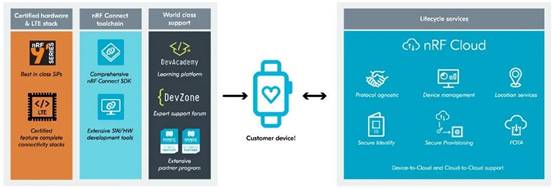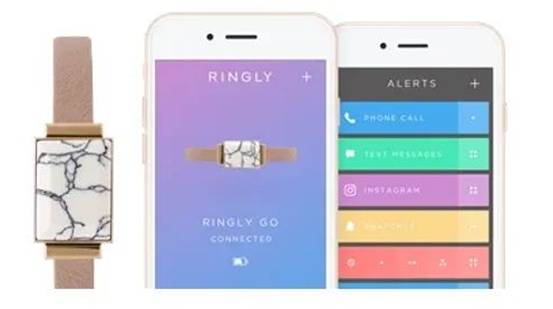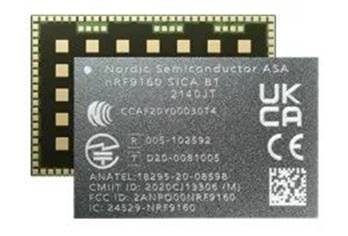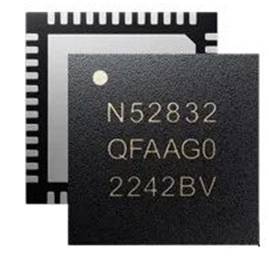Healthcare wearable devices enhance the quality of medical care for the elderly
Time:2024-01-25
Views:259
With the aging of the world‘s population, there is increasing pressure on health and assisted living facilities to provide adequate care for the elderly. At this time, remote monitoring solutions based on the cellular Internet of Things are filling this gap, providing convenient, accurate, and remote monitoring devices for the elderly, and improving the quality of medical care for them. This article will explore the current challenges faced by elderly healthcare and the related solutions launched by Nordic.

The proportion of elderly people using technology is still relatively low
Countries around the world often face the problem of aging populations, and the elderly are the main group who often need to go to hospitals for medical treatment, which brings a heavy burden to governments around the world. However, most patients with illnesses do not like to go to hospitals to see doctors or move from their homes to elderly care institutions because, in addition to the inconvenience of moving out of long-term homes, patients may also lose independence, feel bored, lonely, or worry about being forgotten, which are common reasons for resisting moving to elderly care institutions.
Although there is no way to reverse the passage of time and the process of aging, technology provides an increasing number of methods to assist people in certain situations away from hospitals and elderly care. The provision of healthcare services has shifted towards increasingly relying on technology and data-driven "virtual" care to stay away from hospitals or doctor clinics. However, although the pandemic may have accelerated the adoption of technology, a major obstacle to its application is that many elderly people do not trust or have no understanding of technology, making it difficult to implement in practice.
According to a recent study by Pew Research, although there has been a significant increase in technology usage among people aged 65 and above over the past decade, only 61% of Americans in this age group still own smartphones, and only 75% are internet users. Compared to the smartphone ownership rate (96%) and internet usage rate (99%) of people aged 18 to 29, the penetration rate is still relatively low. In terms of wearable devices, the adoption rate among elderly people in the United States is even lower. According to Statista‘s data, by 2021, only 19% of people aged 55 and above have such devices. Looking ahead to the future, it is necessary to gradually increase the adoption of technological solutions by elderly people to help them stay at home or to assist elderly care institutions in providing more effective care in times of personnel shortages.

The convenience of cellular Internet of Things enhances the technology utilization rate of the elderly
Although Bluetooth‘s low power consumption remains the most popular wireless technology for connected wearable devices, cellular IoT is becoming increasingly popular among health-related wearable devices because it eliminates the need for intermediate connections. For wearers, continuous monitoring can be achieved without the need for smartphones or gateways, and without intervention. For the elderly, this is of great significance as they do not require pairing, smartphones, or remembering Wi Fi network passwords. They only need to reliably and securely send data to the cloud.
Due to the challenges faced by the elderly when using new technologies, these wearable devices must consider ease of use and make it easy for users to operate without having to find applications on their phones or try to remember usernames and passwords. This is particularly important because time is crucial for missing or injured individuals.
It is reassuring that LTE-M and NB IoT low-power cellular IoT provide the gold standard for reliable and secure connections for applications that are critical to life and death. From the perspective of coverage, operators have already launched nationwide coverage networks similar to mobile networks worldwide. This means that most industrialized countries and an increasing number of developing countries provide ubiquitous NB IoT and/or LTE-M coverage.
The cellular Internet of Things is also the safest communication technology, and its built-in security features are part of the 3GPP standard. Additional security can also be applied to chip level devices that provide a secure design product development process. For example, Nordic‘s nRF9160 low-power SiP integrates LTE-M/NB IoT modems, utilizing the additional security layers of Arm TrustZone and Arm CryptoCell to achieve internet level encryption and application protection. This level of security gives developers and consumers peace of mind, especially in the handling and transmission of potentially sensitive personal information on medical wearable devices.



Health monitoring wearable devices based on cellular Internet of Things are becoming increasingly popular
Currently, many companies have developed wearable devices for elderly health monitoring based on cellular IoT, which can be used to track and monitor individuals with Alzheimer‘s disease, dementia, or autism, and can be applied to elderly care institutions or individuals living independently. These wearable devices support LTE-M connectivity and GNSS positioning, and can report the wearer‘s location to family, friends, or caregivers when the wearer is missing. They also integrate accelerometers to detect if the wearer may fall.
In addition, there are also some health wearable devices that use cloud cellular IoT connections, which can continuously monitor and record a series of key health indicators. These devices can integrate pulse oximeters, temperature and inertial measurement unit (IMU) sensors to determine vital signs such as heart rate, blood oxygen, blood pressure, and body temperature. They even include ECG sensors to record heartbeat and rhythm, as well as provide GPS positioning and fall detection functions.
Wearable devices can further integrate cellular IoT and Bluetooth low-power connections into their new healthcare wearable devices, meeting the dual purposes of remote healthcare/remote care solutions and multifunctional devices. Wearers can connect to their smartphones and use them as smartwatches for activity recording, inactivity alerts, sleep monitoring, and fall detection.
These features can provide Bluetooth low-power connections through Nordic‘s nRF52832, supporting call and notification relays from smartphones to wearable devices, and also supporting Bluetooth low-power beacon profiles, allowing for the connection of beacon accessories for indoor location tracking.

Compact and highly integrated system level packaging devices
The nRF9160 launched by Nordic is a low-power system level package (SiP) that integrates LTE-M/NB IoT modems and GPS. It is a compact and highly integrated system level package (SiP) that combines the latest low-power LTE technology with advanced processing and secure access capabilities, making it easy to use and suitable for various single device low-power cellular Internet of Things (cIoT) designs.
The nRF9160 is equipped with an Arm Cortex-M33 application specific processor, a full LTE modem, an RF front-end (RFFE), and a power management system. NRF9160 is a market leading cellular IoT solution with compact, complete, and energy-saving advantages. The nRF9160 integrated modem supports LTE-M and NB IoT, and can operate globally without the need for any regional customization. All energy-saving features, including eDRX and PSM, support IPv4/IPv6, transmission and security (TCP/TLS) levels, and can be upgraded to modem firmware through secure, encrypted firmware wireless updates (FOTA).
The built-in Arm Cortex-M33 application processor in nRF9160 is equipped with 1 MB of flash memory and 256 KB of RAM, making advanced application development possible in a single device solution. It also integrates a GPS receiver, providing various operating modes to adapt to various applications that use location tracking functionality. NRF9160 also comes with a rich selection of universal interfaces and peripherals, including 12 bit ADC, RTC, SPI, and I ² C. I ² S. UARTE, PDM, and PWM.
NRF9160 uses Arm TrustZone technology for isolation and protection of firmware and hardware, including memory and peripherals, and its security is ahead of similar products. Arm TrustZone helps build reliable and secure IoT applications, which have features such as secure boot, trusted firmware updates, and trusted root execution, without affecting performance.
NRF9160 supports Arm CryptoCell by providing cryptographic algorithms and security resources to help protect your IoT applications from various attack threats, further enhancing security. CryptoCell is designed specifically for high-performance cryptographic solutions optimized for power limited devices. NRF9160 supports both SIM and eSIM cards for connection and authentication with mobile network operators.
The nRF9160 hardware and development kit is currently in mass production, suitable for complete end-to-end sensor to cloud development, while Nordic is still developing new features and optimizing performance. NRF9160 supports LTE bands B1, B2, B3, B4, B5, B8, B12, B13, B14, B17, B18, B19, B20, B25, B26, B28, and B66, and has been certified.


Bluetooth low-power SoC supporting multiple protocols and functions
Nordic‘s other nRF52832 system level chip (SoC) is a multifunctional Bluetooth 5.4 SoC that supports Bluetooth low-power, Bluetooth Mesh, and NFC. nRF52832 is a universal multi protocol SoC that meets the needs of advanced Bluetooth ® The application challenges of low energy consumption, protocol concurrency, and enriching peripheral devices and feature sets. In addition, it provides a large amount of memory space for flash memory and RAM.
NRF52832 adopts a multi protocol with full protocol concurrency capability. It supports Bluetooth low power consumption, including 2 Mbps high transmission speed. Bluetooth Mesh can run simultaneously with Bluetooth low-power, allowing smartphones to configure, connect, and control Mesh nodes. It also supports NFC, ANT, and 2.4 GHz proprietary protocols.
NRF52832 is based on Arm with floating-point units ® Cortex ™- M4 CPU, with a main frequency of 64 MHz. Built in NFC-A tags for simplified pairing and payment solutions. It has many digital peripherals and interfaces, such as PDM and I2S for digital microphones and audio, and achieves extremely low power consumption through a precise on-chip adaptive power management system.
epilogue
An increasing number of remote monitoring technology solutions can enable elderly people to stay away from hospitals and elderly care centers, and live more freely at home. The epidemic has accelerated the adoption of wireless medical solutions, but currently, users over 60 years old do not make up a sufficient proportion of the user group. The cellular Internet of Things is favored by remote monitoring devices due to its reliability, security, and no need for smartphones, gateways, or user intervention, and related products will have great potential for future market development. The wireless solution launched by Nordic will reduce the size and power consumption of remote monitoring devices, which is worth further understanding and adoption by manufacturers interested in entering the healthcare application market.
|
Disclaimer: This article is transferred from other platforms and does not represent the views and positions of this site. If there is any infringement or objection, please contact us to delete it. thank you! |











